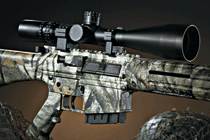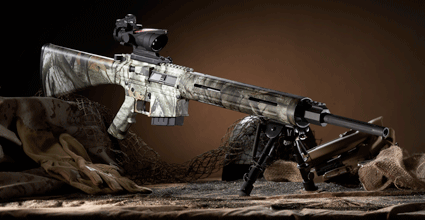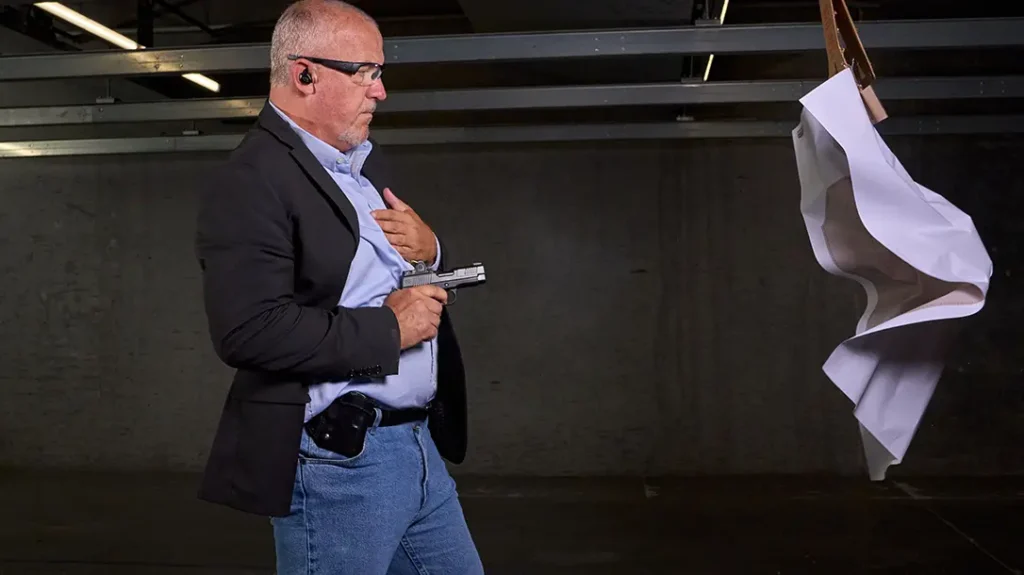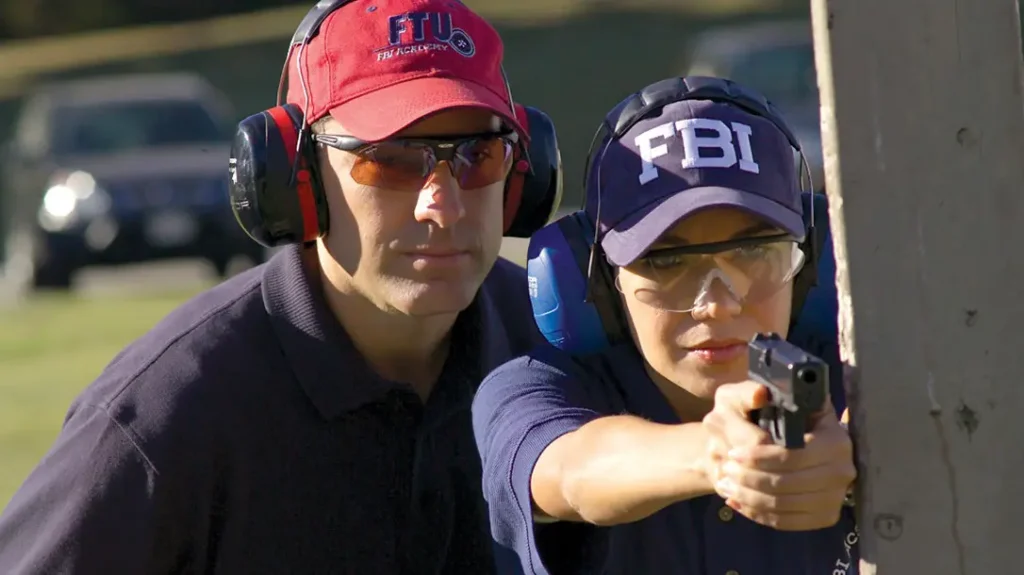It is most quiet just before the action begins, as unknowns are poised to ambush troops at the most devastating moment. Walking among civilians, today’s insurgent enemy takes advantage of the U.S. military’s obedience to the rules of engagement. It is the enemy that chooses the time, and place, to fight. The enemy can be elusive, but tactics used by hunters are finding a place on the modern battlefront.
 General James Mattis determined that Marines of today’s MTV-generation needed a set of skills once embodied by the hunters-turned-Marines of former generations. Successful hunters are keenly aware of the details in their surroundings and are alerted to unusual changes. Implemented in August 2007, a two-week course has grown from Mattis’ concept to having Marines spend time with hunters and police, learning skills to uncover targets in a battlefield environment.
General James Mattis determined that Marines of today’s MTV-generation needed a set of skills once embodied by the hunters-turned-Marines of former generations. Successful hunters are keenly aware of the details in their surroundings and are alerted to unusual changes. Implemented in August 2007, a two-week course has grown from Mattis’ concept to having Marines spend time with hunters and police, learning skills to uncover targets in a battlefield environment.
The Most Dangerous Game
Basic infantry marksmanship and patrolling maneuvers are no longer enough. The enemy isn’t presenting themselves in ranks and columns or open fields. Terrorists use guerilla warfare, civilians for cover and unconventional tactics to create havoc. IEDs and other threats that are hidden in plain sight continue to catch troops unaware.
Advertisement — Continue Reading Below
Combat Hunter is a two-week program at Camp Lejeune, NC and Camp Pendleton, CA. The syllabus is designed to teach Marines how to observe, profile and locate dangerous targets. The observation and pattern analysis skills inherent to hunting, help Marines identify a threat, reduce the risk of casualties and contribute to survivability. Combat Hunter graduates learn how to notice small details and problem solve using unusual behavior or irregularities to detect an ambush or track an insurgent.
Ivan Carter, an African safari guide and hunter from Rhodesia (Zimbabwe) helped to develop the program. “The motto we try to instill in these guys is ‘Marines are always the hunter, never the hunted,’” he says.
The Combat Hunter program also incorporates the experience of police tracking, by employing former police officers to serve as instructors. Those who developed the program looked to the experiences of Marines who had grown up in the inner cities of America. “The inner-city kid has a unique perspective,” says Greg Williams, retired Detroit police officer and Combat Hunter instructor. “They have a strong urban survival instinct.”
Advertisement — Continue Reading Below
When a criminal or fugitive is on the run, they begin to take on animal-like behaviors as a means to escape or survive. To catch such a person, you must be able to anticipate their action before it happens. “All terrorists and criminals follow the same patterns. We give them [Combat Hunters] the ability to think like the enemy. We are giving them the gift of situational awareness,” says Williams.
The Learning Process
Marines enrolled in the Combat Hunter program must master a curriculum designed by the U.S.M.C. Warfighting Lab in Quantico, VA and pass a final exam before graduating. In the first week, Marines learn profiling techniques. They study universal implications on how people act by themselves and towards other individuals. To apply this method, Marines observe a mock village with role players and watch for suspicious behaviors or movements that are unusual to those in the surrounding environment. They learn to look for bulges in people’s clothing, unusual grooming, and to take note of people carrying packages or cases.
In that first week, the program also teaches Marines how to detect a criminal or the leader of a group based solely on behavioral patterns. Dress, specific colors and ornaments can suggest importance. Observing how villagers act and respond to him are proven techniques while monitoring who he approaches or where he travels can lead to vital information.
Advertisement — Continue Reading Below
As a testament to what they learn, four-man teams are assembled to observe a mock village, police station, mosque and market square, simulating the conditions in the Middle East. These students are looking for an enemy. Using their issued Steiner binoculars, the team takes notes, while drawing a map of their target area. They only have a finite amount of time to notice something out of place or detect malicious behavior and prevent an attack by one of the role players.
“The way people walk and act gives hints that something is wrong,” says Pfc. Sean Cowick. “The training provides an ID guide to who is a threat before they can cause damage.”
Week two of the Combat Hunter program starts off with tracking. To become an effective tracker, a Marine has to learn to recognize the unnatural by taking them to the wilderness. “See that? Grass doesn’t grow sideways. They’re taught to notice even minor disturbances such as a broken branch, trampled grass or litter that may indicate someone has passed through,” says Instructor Merriman.
Advertisement — Continue Reading Below
Before the program comes to a close, instructors implement a final exam that has a six-man team track two instructors with a 30-minute head start for several miles. The instructors do not make it easy, as they use stealth and concealment to test the group’s senses. Learning how to age a track by knowing how long it takes a spider to build a spider web is just one example of how this course is more than just learning how to follow footprints.
Overcoming intense heat and erratic weather while crawling through dense brush and traversing natural obstacles challenges each Marine.
Skills of a Hunter
Instructors of the Combat Hunter program emphasize particular attributes associated with the sport of hunting. These hunting attributes include:
Advertisement — Continue Reading Below
– Gather intelligence to select the most likely location to find the target.
– Be aware of the effects of temperature, location of the sun, wind direction and other elements with reference to a target.
– Recognize unnatural elements, like disturbed foliage or trash.
– Be aware of the position that can be viewed by a target against the given landscape, taking advantage of concealment when possible.
– Balance movement with speed and stealth, eliminating unnecessary movement.
– Listen and filter ambient noises to focus on a potential target.
– Be selective, choosing the target with the highest value, threat or tactical advantage.
– Have a complete understanding of the firearm’s function and capabilities, of what to expect when a shot is fired and how to overcome a malfunction.
– Be patient and choose the best moment to break the shot, prepared to make a follow-up shot if necessary.
Using Equipment Differently
As much of the military has concentrated on the development of technology and armor, this program represents a different approach to giving troops an edge in combat. While primarily aimed at developing a new mind-set, this training also integrates a Marine’s gear and teaches them how to become more proficient with its features, using technology in ways many never imagined.
At night, the NVGs (night vision goggles) and thermal sights are utilized to survey and detect unusual behavior in the dark. Cpl. Josue Velney comments, “It was seeing past that, what’s really out there, how to find IEDs with binos, how to use our optics better. As Marines, we run the night.”
Advertisement — Continue Reading Below
Instructors teach them how to use their binoculars effectively, focusing on windows in a target area for observation. They learn how to quickly judge distances and calculate dimensions using known sizes of neighboring objects.
General Mattis told reporters recently, “They look at the entire world differently when they come out of this. That is where we’re going to win this war, by having people who can look at the world differently. It’s not going to be through technology, a new radio or new tank or new gun.”
After Action Report
Lt. Patrick Zuber commanded a platoon that became the first to graduate from the Combat Hunter pilot program in 2007. On deployment, his platoon was standing post outside of Fallujah, Iraq. Reports came in that a man was illegally forcing residents to pay before entering the city. Using skills acquired in training, his Marines noticed a man moving in a crowd who could be spotted talking to people before passing into Fallujah. Once the suspect was apprehended, Marines found a list of people who he had forced payment from and the amounts that each individual owed. “I wish I had this training when I was there before,” says Cpl. Derrick Terrell. “It helps take away the enemy’s advantage on us.”
Advertisement — Continue Reading Below
It may be difficult to quantify the benefit that this program will have, but AARs (after action reports) from commanders in the field indicate that this training is saving lives. “The measure of success right now is when a Marine returns from a patrol convoy or standing a post and is excited that he used the Combat Hunter training,” says Capt. Michael Murray, commanding officer of the training unit that administers the Combat Hunter program. “Units are clamoring to sign up for Combat Hunter. They cannot get enough.”
“Training was an eye-opening experience,” says Sgt. Chris Johnson. “You are never going to see the world the same.” Marines who have participated in this program are thought to be more alert to changes, even in an ordinary environment. Collectively, many report that they have started to notice unusual behavior in their daily lives as their situational awareness has changed. This change is the difference between life and death in a war zone.
























